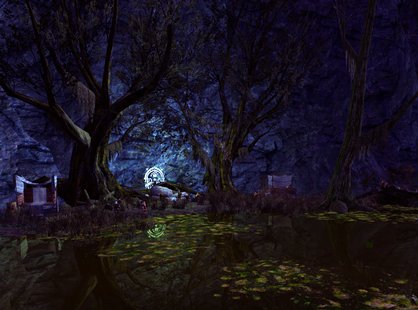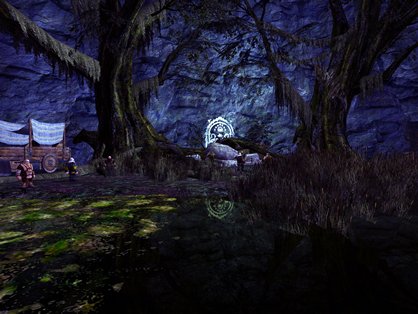Players will also, once through the mines, be able to meet with Lady Galadriel in Lothlórien, as well as rub shoulders with The Fellowship themselves. This is end-game content done differently, with a focus on tight, story-driven questing, small groups and continuing the epic legacy of Turbine’s take on LOTR. The scale of the kingdom is such that executive producer Jeffrey Steefel and Turbine had to reconsider how to build their environments. “It’s a challenge filling any space in a game like LOTRO. What helps us in Mines of Moria is that the space itself is a character. It has a lot of interesting architecture and lore, rather than being a flat space that we have to populate with objects, towns and NPCs. However, you’ve got to use the space right. If it’s just about saying we’ve got X amount of space and each area needs to have Y amount of stuff in it, we’d never succeed.”
Turbine has had to monkey with the engine to texture both the skyline and the ground with the same amount of detail. While this sounds dull, it adds a sense of scale to the caverns on a level unseen in an MMO. Standing on top of a stairwell leading into one of the first caverns of Moria gaveus a genuine sense of nauseating vertigo as things stretched off into the distance – a distance that was fully rendered and accessible. Worse still, we could see the ceiling, resplendent with gigantic stalactites, givingus the feeling that we were in very much a tiny part of a huge, hulking subterranean dungeon. In fact, Turbine are deliberately leaving areas empty to both make it real and establish its scale. “It’s about creating a space that makes sense, and asking yourself what parts need to be filled. There’s a lot of spaces in the distance that are untouched caverns.
“The parts that are touched are markedly different, and that’s the most important thing. It’s a huge challenge – it’s got six distinct environments and we wanted everything to feel new,” nods Steefel. That’s an important part to remember – just because it has ‘mines’ in the title, Moria wasn’t and isn’t an area that’s populated by a series of bland caverns and troglodytes. It’s full of ancient, beautiful architecture, created at the height of Dwarven civilisation and their collaboration with the Elves, ruins corrupted by the Goblins and Orcs, and even the visually stunning waterworks – the science that kept the Dwarves alive below ground. To top it off, any non-instanced content is all in one zone – there’s no loading, just a seamless, gigantic cave.

Your entry into Moria takes place a few weeks after the Fellowship passes through, as you join a plucky bunch of Dwarves in their expedition to break past the Hollin Gate. As you’d expect, things aren’t as easy as opening a door - a vicious squid-like monster called The Watcher attacks, and you have to beat a retreat. To ward off the creature and gain access to Moria, you have to return with a legendary weapon. This is Turbine’s new advancement system that we reckon competitors are going to be wholesale copying very soon. You pick up these items in a bit of a state, and have to take them to be identified by a specialist NPC. Once this is done, they level alongside your character, gaining experience that can be put into ‘legacies’ to improve characteristics. Things become a little complex past that, with each weapon having particularly effective legacies, and the ability to re-forge each one a few times over, making the Legendary Advancement system a potentially endless pursuit of augmenting these magical items.

Luckily, it’s not all content for the high-level stallions, as Mines of Moria introduces two new classes, The Warden and the Runekeeper. The Warden is a medium-armour tank who uses a similar fighting style to Age of Conan. On the surface he only has a few abilities, but by using them in certain orders he can activate gambit moves. These can heal the Warden, taunt enemies to attack, stun opponents or deal damage. The intricacy of the class comes in knowing what gambit moves you’re opening up with each combo, and Turbine touts that it will be one of the most complex classes to play.
Sign up to the GamesRadar+ Newsletter
Weekly digests, tales from the communities you love, and more


